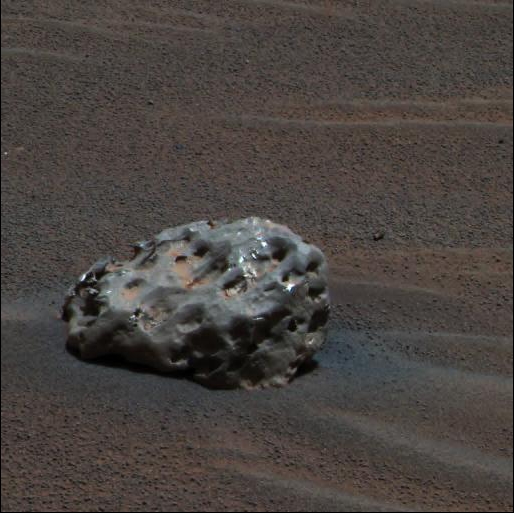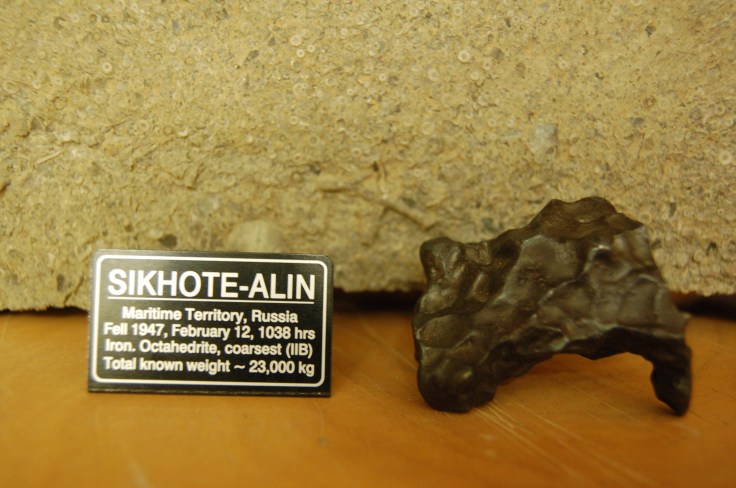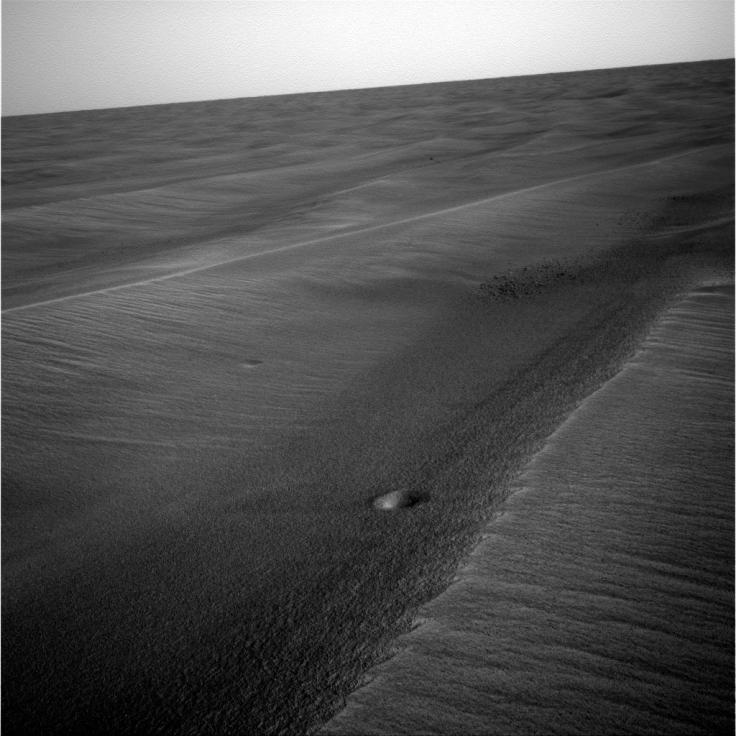Previously we explored some meteorites that have been found on Earth that are very likely from Mars (Finding Mars on Earth). Only a small percentage of the meteorites found on Earth are from Mars with a few more (over 100) originating from the moon. The remainder presumably come from the far reaches of the solar system. Like the martian meteorites these other meteorites have been prized by scientists because they allow them to characterize other places in the solar system without leaving the earth. Envisioning the circumstances that brought Mars rocks to Earth may be difficult but below I want to show you some pictures of meteorites that should be a bit less surprising even if you have never considered their existence. I’m talking now about meteorites on the surface of Mars.
Lets take a look….

The Opportunity rover on Mars has survived an amazing 8 years on the surface of Mars and has traveled many miles exploring three large craters and traversing long stretches of land between its main targets. Above we see a typical landscape that Opportunity has views along the way. This rover has taken literally 10s of thousands of images that look just like this. Well, except for one important detail. That rock in the foreground is way out of place! The flat plains of rock covered by small sand dunes is almost mind-numbingly constant so when a rock like this appears it screams out for an explanation. Although you might be able to propose several explanations for its presence the most obvious one is that this rock dropped from the heavens sometime after the formation of the bedrock material was laid down here.
Lets look at a few more…

This is my favorite one because it is the first meteorite discovered on another planet and I hypothesized that it was it prior to the press release announcing its discovery. During the first year of its mission I followed the Opportunity rover very closely which included looking at the raw images downloaded to Earth each day. One morning this picture came up and I said “hey, there is a meteorite right there on Mars.” How did I know? Partly because I had looked as a lot of pictures and knew that this was a flat boring area with no rocks in sight and so a rock like this had a high likelihood of being a meteorite. More importantly, the shape and obvious texture of the rock screamed out that it has passed through an atmosphere and experienced some melting. But I also had sitting on my desk a piece of meteorite found in Russian that has many of the same characteristics (see picture below). I figured this was probably an iron meteorite and sure enough about two days later there was a press release from NASA announcing the discovery of an iron meteorite on Mars. Or course they guess the same as I had based on similar experience with meteorites here on Earth and knowing the landscape on Mars. They took that initial hypothesis and then tested it with the tools they had at their disposal. They used the rovers arm to touch the rock and determine that it was made of a high percentage of iron element. Such high concentrations of iron do not occur naturally on earth nor are expected to occur on Mars and so a rock of such composition is almost certainly an extraterrestrial rock or in this case and extra-maritan rock.


Yep, another iron meteorite on Mars. I think you are getting the idea now.

This one is a bit tougher. This is an image from the Spirit rover which was traversing the inside of a huge crater on the other side of Mars and has been seeing a lot more diverse landscapes with rocky outcrops. But check out those two large lighter colored blocks in the foreground of this scene. Yes, two more meteorites or maybe one that broke into two pieces.

There is the Opportunity rover again for scale and you guessed it, yet another probable meteorite. I don’t think that Opportunity even bothered to do any measurements on this one. Once you have seen a couple they aren’t so special anymore. These meteorites may have been sitting here for 10 days, 10 years, 10,000 years or a million years. It is hard to know but these iron meteorites wouldn’t last a 100 years on the surface of Earth because they would simply rust away. We have water and O2 in the atmosphere. Mars has neither and because they are so hard they experience extremely slow erosion rates. It would take millions of years for wind to erode these away. As a result these meteorites build up in concentration on Mars while on Earth iron meteorites are very rare to find. The rovers have been seeing iron meteorites every couple hundred meters and there are probably 100 very small meteorites that go unnoticed for every larger one that they find. What is more interesting is that other places on Mars where the surface has had less change (here the dunes could be covering up many meteorites as they shift over time) there appear to be a higher concentration of similar rocks. In a way the relative age of a landscape can be roughly determined by the difference in number from one location to another since we can assume that the chances of a meteorite fall at all locations near the equator of Mars are the same.

In the picture above you can’t see a meteorite but you can see evidence that a micrometeorite has landed here. In fact, a bit further away it appears there might be a second, probably older, micro-crater (I say older because it appears to have eroded some). In the past I have used a similar picture in one of my non-majors science classes and asked them to suggest hypotheses for the origins of what they are observing. Some suggest that the rover touched its arm down here, others suggest that wind has caused this, sometimes I get the suggestion that a crack int he rock below is caused sand to fall down creating this tiny sinkhole. Usually a few people will suggest a meteorite. I always point out that if they lived in the western US they might be temped to blame ant lions which dig holes in the sand that look just like this and wait for an ant to slide down the scope into their open jaws at the bottom. Hypotheses are educated explanations for something we observe. There are always many possible explanations but further testing will sort out which hypotheses is most likely. To test the micrometeorite hypothesis we could dig up the sand and see if we can find the culprit. We could also test the other hypothesis by examining predictions from them. Is there a crack in the bedrock under this sand dune? I point out to the students that the arm of the Opportunity rover can only extend a couple feet from the edge of the rover and this little crater is at least 6 feet away so I would predict that if the rover were responsible we should see wheel tracks very close to it.
How old are these small craters?
The meteorites lying on the surface or mars and the impact craters that some produce can tell us quite a bit about the history of the planet. While it is very difficult to say exactly how long ago these meteorites landed on Mars they do tell us about the relative history of events. For example the two “micro” craters in the picture above can be inferred to be of different ages based on how much each one has been filled wish Mars sand. The closer one seems very fresh as it happened yesterday but the Opportunity rover has been roving for 8 years and has not observed any wind during that time that has caused any shifting of sands in this area. When was the last time there was enough wind to move any significant sand is not known but it could have been 10 years or 10,000 years ago or much much longer? I would point out for those that known Martian climate studies that Mars is known to have a severe wobble over 5 million years and so the climate is expected to have been very different at a maximum of that long ago.
I have noticed many similar micrometeorite impact craters on the rovers travels suggesting that either the rate of meteorite impacts on Mars is very very high compared to Earth or these craters are being preserved for much much longer on Mars. If these sands were constantly shifting even over thousand year periods I would not expect the number of meteorite impacts such as these should not be as evident as they are. My prediction would be that if the Curiosity rover finds more active dunes in Gale crater that it won’t find as many micrometeorite impacts there. By quantifying the number of these small impacts and meteorites on the surface at different locations the relative ages of these sites can be determined.

Above we see the result of a larger meteorite impact on the surface of Mars. If you look at this image in full size you will see that there are a couple of black rocks mixed in which could possibly represent the remains of the meteorite that caused this little crater. This crate is rather “fresh” in appearance compared to the one in the background which has been eroded down to smooth sides and a flat top. Eventually wind will erode the rocks that were excavated from this crater until they just become more sand on the surface. That will probably take several million years unless there is some new erosive force available in the future (lots of water would definitely speed things up). How old is this crater, probably very old but young compared to the other features in this picture. The crater in the distance if far older (maybe a billion years older!) and has experienced massive amounts of erosion. The plains in the foreground had to be eroded down to the flat bedrock that we see now (image that at on time there were mounds of material that were ejected from the crater in the distance that have since all worn away by the wind) before this new crater was formed. The rocks thrown our are still a bit jagged but clearly have experienced some erosion and so are likely to be thousands or 10s of thousands of years old at least.
So meteorites have played and continued to play a big role in shaping the surface of Mars. The time scales are difficult to comprehend staring at these pictures but the appearance of very different amounts of erosion paint a clear picture of large time differences between events. I have explored these time differences and their implications in more depth in other articles. For those discussions please see:
Kamil Meteorite Crater: A “Young” Impact on Earth Compared to Craters on Mars
Alternative Understanding of Gale crater with (low-nickel) ‘iron meteorites’ and basaltic slag:
Alternative, but the only explanation the abundance of centimeter- and decimeter-scale basaltic rocks on Mars.
Gale crater is an Oort cloud icy body impact basin with metallic-iron and basaltic-slag dark-matter crust from the icy body.
‘Reionization’ of the universe began about 150 million years after the Big Bang which condensed most of the primordial hydrogen and helium inside pre-existing gravitationally-bound proto-galaxies into gravitationally-bound ‘globules’, known as Bok globules when stellar metallicity becomes volatilized, making them opaque and thus visible.
The vast majority of Bok globules, consisting of 4/5 of the Milky Way’s mass in the form of cold dark matter, orbit in highly-inclined disk-crossing orbits. The gravitationally-bound globules sweep up stellar metallicity during disk crossing which rather quickly condenses into icy hailstone chondrules. With condensed stellar metallicy, the remaining molecular hydrogen and helium at around 10 Kelvins is almost completely invisible and thus dark.
When the solar system occasionally passes through Bok globules, causing glacial periods on Earth, Oort cloud comets and dwarf planets sweep up some of the stellar metallicity which forms a crust on the surface, and carbon monoxide in the icy chondrules chemically reduce metal oxides to their metallic elements. Then subsequent galvanic reactions on planetesimal surfaces or subsequently on Mars with melted water as the electrolyte likely melt a portion of the granular centimeter-sized metallic-iron and basaltic slag into larger decimeter-scale massive iron and basaltic slag.
The Sun sublimes icy chondrules in solar system transits of Bok globules, protecting the Moon and inner terrestrial planets, but sustained passages of the solar system through giant molecular clouds which have trapped Bok globules from their halo orbits may be the origin of dark-matter metallicity cap carbonates during Snowball Earth episodes, and may also also partially explain “the dolomite problem”. Bok globules also perturb weakly-bound Oort cloud planetesimals, creating showers of comets and dwarf planets at irregular intervals in the inner solar system and dwarf-planet impacts are responsible for the major extinction events on Earth; however, compressible ices in icy-body impacts largely clamp the impact-shock pressure below the melting point of silicates, masking icy-body impact ‘basins’ from detection as such. So rocky-iron asteroids excavate classic impact craters with melt rock, whereas icy-body impacts merely compress the unmelted target rock into a basin.
LikeLike